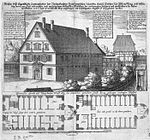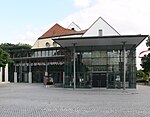Warner Barracks was a United States Army military base in the city of Bamberg, Bavaria, southern Germany. The base had been occupied by U.S. forces since the end of World War II. Elements of the U.S. Army's 3rd Infantry Division and 45th Infantry Division entered the town on 13 and 14 April 1945. But before the war, this military site had a colorful history that goes hand-in-hand with Bamberg's history, which began in the 10th century. Bamberg was originally a fort on a hill. The view enabled soldiers of the time to watch the city and guard it against possible attacks. In 973, the Duke of Bavaria gained control of the fort. The city and fort fell under Swedish Protestants' control during the Thirty Years War when the Swedes engulfed the city and took it forcibly in 1634.
In 1891, Warner Barracks, later known as "Lagarde Kaserne", was built by the Royal Bavarian Army as an infantry barracks. Many of the buildings to the west were constructed around the start of the 20th century, and several of these are classified at historical monuments. From World War I to World War II, almost every branch of the German Army was stationed here, the most famous being the 35th Tank Regiment and the German 17th Cavalry Regiment Archived 2010-01-19 at the Wayback Machine. In 1917, the present Muna area was established and, in 1928, the present airfield was added. After 1933, the forces here were augmented with the addition of the 79th Artillery Regiment, and in 1936, Warner Barracks I, the eastern portion of the military base, was constructed as "Artillery Kaserne".
Prior to World War II, almost every branch of the German Army was stationed at Warner Barracks at some time, the most elite being the 35th Armor and the 17th Cavalry Regiments. The cavalry was composed of noblemen who were wealthy and had their own riding school. Claus von Stauffenberg, who was known for 20 July plot of 1944 to assassinate Adolf Hitler, served in the cavalry regiment; it was his family's traditional regiment. The stables and school occupied the PX, Commissary, and community engineering areas. After World War II, the headquarters of the U.S. Constabulary, created to occupy Germany, was located in Bamberg. The Constabulary was a highly mobile unit made up of the 26th Infantry Regiment and the 1st Infantry Division. The unit was responsible for patrolling the American occupied quarter of Germany.
In 1955 the 10th Infantry Division, by Operation Gyroscope, replaced the 1st Infantry Division at Warner Barracks.
In June 1948, the Soviets imposed the Berlin Blockade changing the United States' role in Germany from occupier to defender. The Constabulary was eventually phased out. The current Warner Barracks complex was appropriated in 1950 by U.S. forces and renamed in honor of Cpl. Henry F. Warner. Warner was killed in action on December 21, 1944 after his heroic anti-tank actions in Bütgenbach, Belgium. He was posthumously awarded the Medal of Honor six months later, on June 23, 1945.
In 1951, development for long-term use of the post began. A dispensary, dental clinic, schools, a PX, gymnasiums and an education center were established.
The post commander was always the senior officer of the infantry brigade until 1970 when Bamberg became an official U.S. Army Europe community with a general officer appointed as post commander.
Over the years, the installation was a sub-community of All the installations located in Frankfurt, Nuremberg, and Würzburg. U.S. Army Garrison Bamberg is subordinate to United States Army Installation Management Command – Europe and is an indirect report garrison under USAG Ansbach Archived 2019-01-17 at the Wayback Machine.
Units from the 1st Battalion, 6th Field Artillery Regiment, 1st Battalion-33rd Field Artillery Regiment, 173rd Airborne Brigade Combat Team, 16th Sustainment Brigade, 18th Engineer Brigade, and 2nd Armored Cavalry were stationed on Warner Barracks.
On September 12, 2014, the U.S. Army Garrison Bamberg hosted a joint American-German ceremony to officially close Warner Barracks and turn it over to the German government.
the 1/75 field artillery was stationed there as well.











